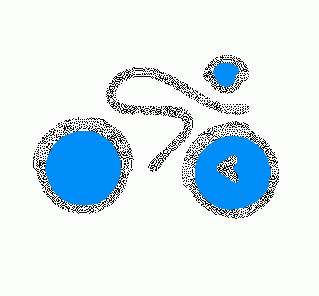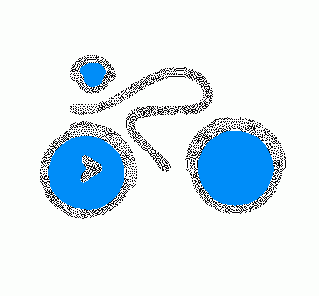| Newsletter - 2001 Archive |

|

|
Cycling Club |

|

|
| Newsletter - 2001 Archive |

|

|
Cycling Club |

|

|
Next--->
A group of six Japanese cyclists including this writer visited Vancouver B.C. from June 14 to June 20 to participate in a 600 km. Qualifying Brevet.. We were kindly invited to participate by the sponosoring organization, the B.C. Randonneur Club yet though none of us had participated in the 200, 300 or 400 km brevets.
Our visit to Canada was to be the first step towards organizing a series of brevets in Japan which would qualify Japanese cyclists for the 2003 PBP. As of today, brevets that would qualify under the PBP rules are non-existent in Japan , though we have several long distance cycling events throughout the year. Thus, our objective for visiting Canada, was to observe first hand how a qualifying brevet was organized, as well as to ascertain the level of bicycling skill required to complete the longest of the qualifying brevets.
The Japanese delegation was comprised of Mr. Ishimaru and Ms Yuko Kato, representing Brevet Japon ( also representing Star Bike Japan, organizers of many long distance events in Japan) and , Mr. Kusano a writer from Cycle Sports, one of our major cycling magazines, Mr. Sudo, Ms. Sawada and myself, Maya Ide.
Background
Last fall I received a phone call from Ms. Kato of Brevet Japon
asking me to help her in her correspondence with the World Randonneur
Association or Randonneurs Mondiaux. Since 1994, Ms. Kato and
members of Star Bike Japan had been organizing along distance
cycling event known as the Route N. Mr. Ishimaru and Ms. Kato
had visited France to observe the PBP in 1999, and had been negotiating
unsuccessfully with the Audax Club Parisien to have the Route
N designated as a qualifying brevet. Mr. Real PreFontaine, the
new president of les Randonneurs Mondiaux, had been most supportive
of our hopes to send Japanese cyclists to the PBP in his correspondence
with Star Bike Japan. From around January 2001, I began to exchange
e-mail with Real on behalf of Ms. Kato.
It became increasingly evident that we needed to revamp the Route N and start from scratch if we were to organize the series of qualifying brevets. Route N for one thing was not administered as a group ride, and therefore there were no control points. Usually ridden on an individual basis, the rider applies for a 350 km, 500 km or 750 km badge. Though Star Bike designates many Route N routes throughout Japan, the rider can also plan his or her own route, or combine several of the designated routes. The rider collects either train tickets or convenience store receipts imprinted with a date and time every 30 to 50 km to be mailed later as evidence. At the goal, the rider must get a signature of a third person as proof that the ride has been completed.
I also started exchanging e-mails with Mr. Yonemitsu, a very active member of the BC Randoneur Club and a Japanese, and Mr. Harold Bridge, the organizer for the August Haney ride. Both Real and Mr. Yonemitsu in the mail repeatedly encouraged us to participate in a 600 km brevet, so that it would serve as a model to be applied in Japan.
Mr. Ishimaru, Ms. Kato and myself spent several hours at the Star Bike office discussing whether we should go. Could we get riders who would be able to successfully ride a 600 km brevet, and who would be willing to travel all the way to Canada? I argued that we should invite only a handful of very strong riders. Mr. Ishimaru, with his many years of experience as a bicycle event organizer insisted that we should broadly advertise the event and solicit the participation of as many cyclists as possible. He argued that it was important to garner wide support among Japanese cyclists. As a result of those discussions, in April we posted an advertisement for a bicycle trip to Canada in August for the Haney 600 km ride. I would like to take this opportunity to thank Mr. Harold Bridge for mailing me maps and other pertinent information for the advertisement.
From around March, I had been contacting our local clubs and the organizers of an annual 300 km ride from Tokyo to Niigata Prefecture on the Japan Sea Coast side, but was not getting any encouraging responses. Many seasoned long-distance cyclists seemed to balk at the thought of traveling to Canada to ride 600 km in 40 hours. Since the ride we were initially planning to do was in August, normally summer vacation time in Japan, I had actually been worried that too many cyclists might apply for the tour. That not being the case, I decided to ask Mr. Niwa, a mountain bike tour guide to introduce me to anybody who had the ability to ride 600 km. He at once took out his cell phone and called Mr. Kusano at Cycle Sports Magazine. Mr. Kusano had ridden 500 km at a stretch, and immediately agreed to accompany us. I was so relieved. Now I could mail Real, Mr. Yonemitsu and Harold that we were coming to Canada.
In April Mr. Sudo, another long-distance mountain bicyclist also signed up, and along with Ms. Sawada who was making her own arrangements with Mr. Yonemitsu, we were able to gather a team of four riders, including myself. Ms. Kato and Mr. Ishimaru would drive the support van for the benefit of the Japanese cyclists. By this time, we had decided to heed Mr. Yonemitsu's suggestion that we do the June Cache Creek 600 km ride to take advantage of the long daylight in Canada.
A Japanese impression of the roads in
Canada
Since the readers of this translation will be familiar with the
Cache Creek route, in this section, I will only summarize my impression
of the route..
Coming from Japan where 98% of the land area is mountainous, I was surprised to learn that the first 120 km was flat except for a short but steep climb near the Slough McCallum right before the turn off to Harrison Springs. On top of this hill, I found a site that is very common in Japan. A historic fountain of natural water, surrounded by people filling up their water tanks or bottles.,p. The roads ran straight for stretches of several kilometers, and with a strong tail wind, it was an easy ride up to the first checkpoint, Sea Bird Island Cafe. The lack of traffic signals, and the wide side lanes allowed me to cycle with a sense of safety, yet though the traffic was at times fairly heavy with an endless stream of trucks.
Though the average gradient beyond Hope was 7%, because of the width of the lanes, the size of the trees, and the variegated contours of the mountains that hemmed in the canyon, and perhaps thanks to a strong tailwind, the climb did not seem to be as steep as most Japanese mountain roads. I particularly loved the route beyond Yale leading up to Boston Bar, not only because of the spectacular scenery, but because the roads were so well designed, faithfully following the natural contours of the hills.
Beyond Yale, the road traversed the mountain side high above the river, winding around huge overhanging crags with barely a sidefence to keep the cars from plunging down the cliffs. Up and down and zigzaging from one crag to another, oh was I envious, because in Japan, our mountain roads are becoming increasingly straight. Many historic routes that used to travel across mountain passes are disappearing, and are being replaced by long tunnels. Left to Japanese road builders, the Fraser Canyon route would surely have been a series of tunnels, depriving the cyclist of those wonderful views.
The quaint little towns enroute were a joy to pass through. I had to chuckle at the sign that appeared before every settlement. "Don't use engine brakes in urban areas". Obviously my definition of the term urban was a bit different.
Beyond the point where the Fraser and Thompson rivers diverge I enjoyed the barren landscape, devoid of human settlements for a stretch of nearly 70 km, yet though a 20 km long road construction right before Spencer's Bridge was agonizing. By the time I reached the Acacia Grove Motel at Spencer's Bridge, it was raining, the temperature had plunged, and I was thoroughly soaked. I was on the point of giving up, but after changing into winter attire, I set off towards Cache Creek. As the sun set, it became pitch dark, but the sweet scent of sage brush, the serenity of the night, and the stars that appeared among the clouds kept me going on. It was not until nearly midnight that I reached Cache Creek. I was tired, ravenously hungry, but had enjoyed every inch of the ride.
Perhaps because of the wind factor, I had to peddle on nearly every descent, which actually came as a surprise. In Japan, many mountain routes have a road gradient of at least 10%. Though the climb is steep, usually you are rewarded by an exhilerating descent. This is probably due to the fact that the Japanese mountains are young and steep, and we are geographically much smaller than Canada. A 300 km ride in Japan would take you clear across the width of Japan, from the Pacific Coast side to the Japan Sea Coast side.
When we organize qualifiying brevets in Japan the number of traffic signals might prove to be a hinderance. For example, on a 300 km route between Tokyo and Itoigawa, on the Sea of Japan Coast there are 234 traffic signals as opposed to only 10 traffic signals between Pitts Meadows and Cache Creek. On the other hand, because convenience stores are so ubiquitious even in rural areas, we do not have to carry provisions, even on long rides. The Ministry of Construction also operates so-called Road Stations (as opposed to railway stations) along most country roads. These road stations have restaurants and clean restrooms, as well as stores that sell local produce. They cater to traffic on general roads, as opposed to major highway traffic, and would serve as wonderful control points for a qualifying brevet.
Results of the Japanese cyclists
Mr. Kusano and Mr. Sudo successfully completed the 600km ride
in 37 hours 45 minutes. Ms. Sawada rode for 450 km and retired.
Being visually impaired, she was able to ride the distance only
because of the strong support given by Mr. Yonemitsu who guided
her. I retired at Cache Creek, the 300 km point, partly out of
fear that Ms. Kato and Mr. Ishimaru would find it difficult to
support both the front runner, Mr. Kusano, and myself, the last
cyclist among the participants.
Lessons learned
The event was an eye opener for all of the Japanese participants.
All of the Japanese participants were impressed with the simple
and yet thorough manner in which the brevet was managed, with
the cooperation of many volunteers and the local community. We
learned much about how to use the control cards, and how to manage
control points such as Spencer's Bridge. Most of all, we were
able to experience the level of skill required do complete a 600
km ride within 40 hours. All in all, we returned from Canada confident
that we too could organize the series of qualifying brevets in
Japan. This July upon our return from Canada,we held our first
Randonnuer Japan meeting. We have since decided to hold our first
trial 200 km brevet on September 30. Next year. we plan to organize
the first series of Brevets in preparation for the 2003 PBP.
On behalf of the Japanese visitors, I would like to express our sincerest appreciation to the B.C. Randonneur Club, to Mr. Real PreFontaine and Mr. Noboru Yonemitsu for their strong support and guidance. We hope that we can reciprocate by inviting BC Randonneur members to come out to Japan. There are many wonderful routes in rural Japan that we would like to show you. On the Japan Sea coast side, as well in the northern parts of the country, the scenery is beautiful, traffic is minimal, and the roads are wide. If there are any interested members, please contact Ms. Kato or myself.
[Provided by Noboryu Yonemitsu... Nobo]
_